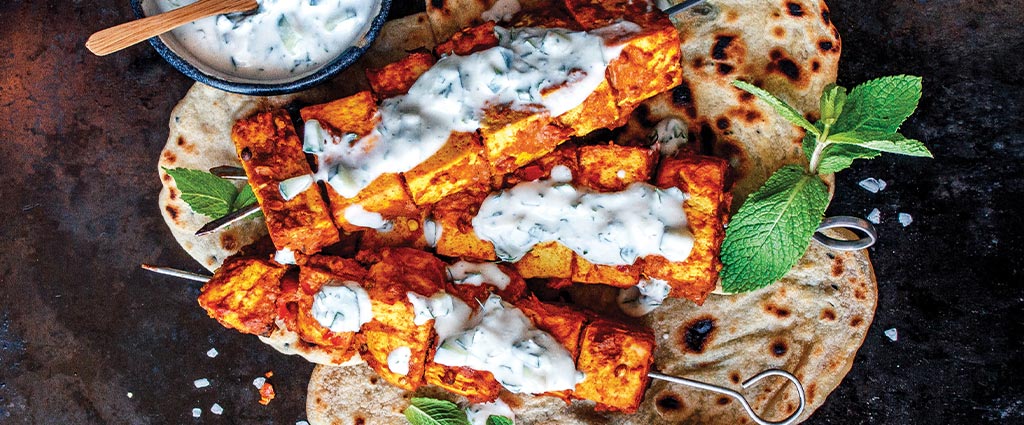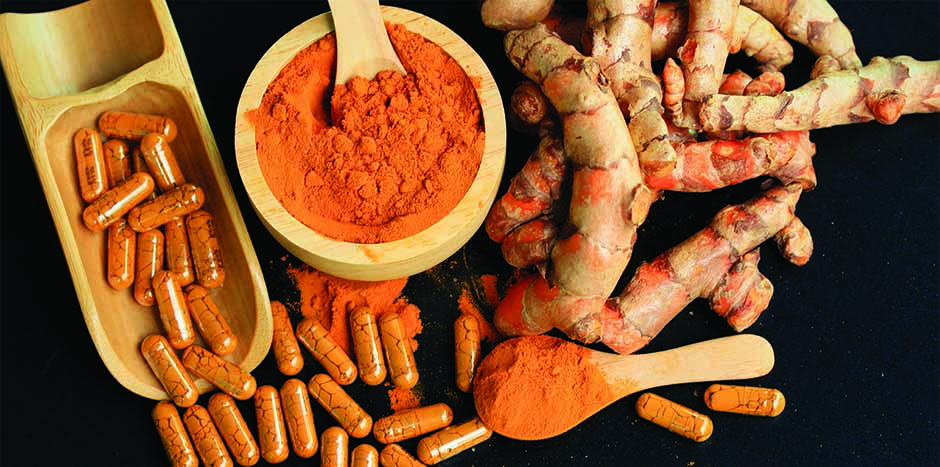Cooking with Turmeric: Benefits & How-To
A member of the ginger family, turmeric is full of flavor and potential health benefits.
Cooking with Turmeric: Benefits & How-To
A member of the ginger family, turmeric is full of flavor and potential health benefits.
Known as the “golden spice” because of its lovely golden-brown color, turmeric has been revered for thousands of years for its signature flavor as well as its medicinal uses. A major component in curries, turmeric’s benefits come from its curcuminoids, which are yellow and can be used to color foods and cosmetics, too.
What is it?
Turmeric is a plant of the ginger family with a long history of medicinal use. Turmeric is a rhizome, or the part of the plant that grows underground like a root. The use of turmeric dates back nearly 4,000 years to the Vedic culture in India, where it was used as a culinary spice and had religious significance.
RECIPES USING TURMERIC
What are its potential health benefits?
Turmeric is known for its anti-inflammatory, antioxidant properties largely related to its curcuminoid content. Curcuminoids are polyphenols, or natural components of a plant’s defense system. Curcuminoids comprise about 2%-9% of turmeric, with curcumin making up 75% of that content and giving turmeric its yellow color. Turmeric and its curcuminoids have been extensively studied for their health effects. Studies have shown turmeric to improve inflammatory effects in diseases like arthritis, metabolic syndrome and Alzheimer’s disease. One study found curcuminoids in turmeric to have an anti-breast cancer effect by inhibiting cancer cell growth. While findings are promising, long-term clinical trials are needed before clear conclusions can be reached about whether turmeric has benefits for health conditions.
Try Turmeric
The roots of the turmeric plant are dried and made into capsules, tablets, teas and other extracts.
How do you cook with it?
Turmeric is a widely used spice in South Asian and Middle Eastern cooking. It can be eaten fresh or dried. To eat fresh turmeric, use a vegetable peeler to remove the outside skin and grate the flesh into a soup, tea, smoothie, lentils, rice, egg dishes, or in a marinade for chicken or fish. Dried turmeric can be found in the spice aisle as ground turmeric or in curry powder. Try roasting vegetables like cauliflower with ground turmeric, olive oil, salt and pepper; add turmeric to a curry; or make (yes) chocolate milk! You can even find turmeric in pre-made juices now.
A few tips and tricks:
– Curcumin is not well absorbed by the body and is rapidly metabolized and excreted. Combining curcumin with black pepper has been found to increase bioavailability of curcumin in humans. Next time you use turmeric, add some black pepper along with it.
– Turmeric’s vivid color may stain your hands and counter! To remove a counter stain, try a mixture of baking soda and water.
Known as the “golden spice” because of its lovely golden-brown color, turmeric has been revered for thousands of years for its signature flavor as well as its medicinal uses. A major component in curries, turmeric’s benefits come from its curcuminoids, which are yellow and can be used to color foods and cosmetics, too.
What is it?
Turmeric is a plant of the ginger family with a long history of medicinal use. Turmeric is a rhizome, or the part of the plant that grows underground like a root. The use of turmeric dates back nearly 4,000 years to the Vedic culture in India, where it was used as a culinary spice and had religious significance.
RECIPES USING TURMERIC
What are its potential health benefits?
Turmeric is known for its anti-inflammatory, antioxidant properties largely related to its curcuminoid content. Curcuminoids are polyphenols, or natural components of a plant’s defense system. Curcuminoids comprise about 2%-9% of turmeric, with curcumin making up 75% of that content and giving turmeric its yellow color. Turmeric and its curcuminoids have been extensively studied for their health effects. Studies have shown turmeric to improve inflammatory effects in diseases like arthritis, metabolic syndrome and Alzheimer’s disease. One study found curcuminoids in turmeric to have an anti-breast cancer effect by inhibiting cancer cell growth. While findings are promising, long-term clinical trials are needed before clear conclusions can be reached about whether turmeric has benefits for health conditions.
Try Turmeric
The roots of the turmeric plant are dried and made into capsules, tablets, teas and other extracts.
How do you cook with it?
Turmeric is a widely used spice in South Asian and Middle Eastern cooking. It can be eaten fresh or dried. To eat fresh turmeric, use a vegetable peeler to remove the outside skin and grate the flesh into a soup, tea, smoothie, lentils, rice, egg dishes, or in a marinade for chicken or fish. Dried turmeric can be found in the spice aisle as ground turmeric or in curry powder. Try roasting vegetables like cauliflower with ground turmeric, olive oil, salt and pepper; add turmeric to a curry; or make (yes) chocolate milk! You can even find turmeric in pre-made juices now.
A few tips and tricks:
– Curcumin is not well absorbed by the body and is rapidly metabolized and excreted. Combining curcumin with black pepper has been found to increase bioavailability of curcumin in humans. Next time you use turmeric, add some black pepper along with it.
– Turmeric’s vivid color may stain your hands and counter! To remove a counter stain, try a mixture of baking soda and water.
ABOUT THE AUTHOR
Taylor Newman, PhD, RDN, LD, is the Nutrition Program Development Manager at Kroger. Taylor's extensive education in nutrition and research makes her a valuable myth-busting resource for her patients. She enjoys hiking, registering people to vote and attending events in her community. She also aspires to hike at all of the national parks!
Did you know? You can meet virtually with a Kroger dietitian to help you achieve your personal wellness nutrition goals. Learn more about Telenutrition.
ABOUT THE AUTHOR
Taylor Newman, PhD, RDN, LD, is the Nutrition Program Development Manager at Kroger. Taylor's extensive education in nutrition and research makes her a valuable myth-busting resource for her patients. She enjoys hiking, registering people to vote and attending events in her community. She also aspires to hike at all of the national parks!
Did you know? You can meet virtually with a Kroger dietitian to help you achieve your personal wellness nutrition goals. Learn more about Telenutrition.











Comments
Home and business owners wish they had the resources to keep their structures in pristine condition. The potential dangers of cleaning roofs or gutters are also discussed. I need a House Washing Sunshine Coast service at https://housewashingsunshinecoast.com.au/ that uses low-pressure, soft high-pressure washing close to the water. However, it is still preferable to use a Gerni to clean it yourself. No matter how big or little your property is, their crew of exterior house cleaners will give it a makeover.